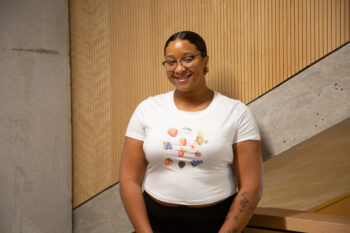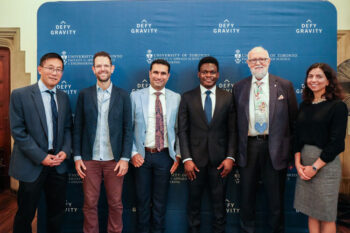Smartphones could soon join axes, ladders and helmets as indispensable tools of the firefighting trade, thanks to a group of recent graduates from U of T Engineering. While still undergraduate students, they developed an app that can help firefighters take control of their health by tracking the hazards they are exposed to as part of their jobs.
“A fire at an old industrial warehouse could release asbestos, or chemicals that are either carcinogenic themselves, or generate carcinogenic byproducts,” says Professor Graeme Norval (ChemE), an expert on chemical safety. “The challenge is: if somebody’s health deteriorates, how do you determine if it’s a workplace effect or not?”
A couple of years ago, Norval was discussing the problem with Colin Grieve, a member of the Hamilton Professional Firefighters Association (HPFA). Both Grieve and Norval serve on the Prevention Council, an advisory body to the Ontario Minister of Labour. Grieve told him that currently HPFA members fill out a yearly health questionnaire, but that they were looking for a better system. Norval had the solution: he brought the idea to U of T Engineering’s Multidisciplinary Capstone Design Course.
A group of four undergraduate students — Shatha Abuelaish (CompE 1T5), Priyadeep Jaswal (CompE 1T5), Fei Ba (IndE 1T5), and Alex Liu (IndE 1T5) — took on the challenge. They quickly digitized the questionnaire, but they also saw potential to go further. “When you’re recording the information just once a year, it’s hard to remember what has happened,” says Abuelaish. “By contrast, an app is more easily accessible immediately after the exposure.”
The team developed an app called Xposure that firefighters can download and use in the hours immediately after a call. The app’s multi-level menu adapts to a given user’s responses, zeroing in on the most relevant questions for particular exposure, making it more intuitive than a paper questionnaire.

“Our members absolutely love it,” says Rob D’Amico, vice-president of HPFA and a captain with the Hamilton Fire Department. “It’s quick and easy, and they can do it as they are riding in the truck, when they get back to the station, or even when they get home.”
The data collected by the app can be used to support Workplace Safety and Insurance Board claims if and when a firefighter experiences health effects based on their exposure. But the information becomes even more powerful when it is anonymized and brought together with input from other firefighters to create a database.
“We can do data analysis to notice patterns and trends,” says Abuelaish. “Instead of waiting until a person starts experiencing health issues, we can predict ahead of time what they are likely to face, and take preventative action.”
The original app was designed for iPhones and is now being used by more than 50 HPFA members. After finishing the capstone course, Abuelaish was contracted by the HPFA to adapt it for Android so that it could be made available even more widely. “We’ve already had other locals asking us about it,” says D’Amico. “We will be putting them in touch with Shatha. Working with her has been a great experience, and we could never have done it without her.”
Norval agrees that the app has great potential not just locally, but around the world. “The entire firefighting community has the same problem,” he says. “For example, there is lots of data looking at the first responders from 9/11 who were exposed to all the dust and things that came out of the World Trade Centre collapse. We know that it’s a real phenomenon, but it’s still hard to say how much exposure leads to what effects. Having this kind of quality data will make a big difference.”




